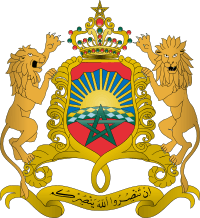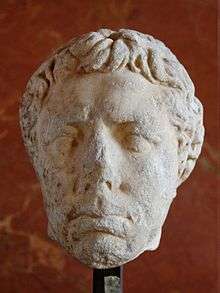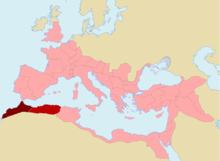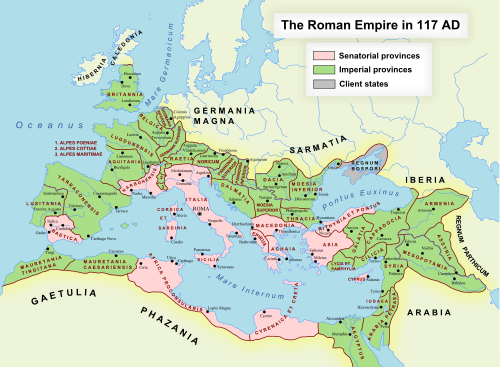Mauretania
| Mauretania | ||||||||||
| Tribal Berber kingdom (3rd century BC-44 BC) Roman Empire province (44 BC-431 AD) | ||||||||||
| ||||||||||
 Mauretania Tingitana province (borders in AD 116). | ||||||||||
| Capital | Volubilis[1] | |||||||||
| Languages | Berber, Latin | |||||||||
| Religion | Roman paganism, local beliefs | |||||||||
| Political structure | Tribal Berber kingdom (3rd century BC-44 BC) Roman Empire province (44 BC-431 AD) | |||||||||
| King | ||||||||||
| • | 110–80 BC | Bocchus I | ||||||||
| • | AD 23–40 | Ptolemy of Mauretania | ||||||||
| Historical era | Classical Antiquity | |||||||||
| • | Established | before 200 BC | ||||||||
| • | client state of the Roman Empire | 33 BC | ||||||||
| • | Roman province | 44 AD | ||||||||
| • | Vandal conquest | 430s | ||||||||
| • | Roman reconquest | 533 | ||||||||
| • | Muslim conquest of the Maghreb | 698 | ||||||||
| ||||||||||
Part of a series on the |
|---|
| History of Morocco |
 |
|
Related topics
|
|
|
Mauretania (also spelled Mauritania)[2] was in ancient times a part of North Africa corresponding to the Mediterranean coast of what is today Morocco (and the Spanish cities of Ceuta and Melilla).
Mauretania originally was an independent tribal Berber kingdom from around the 3rd century BC. It became a client state of the Roman empire in 33 BC, then a full Roman province after the death of its last king Ptolemy of Mauretania in AD 40.
Mauretania fell to the Vandal invasion in the 430s, but was reconquered by the Eastern Roman Empire in 533. There was a time of weak Byzantine rule when the territory was practically independent. The province was finally conquered by the Arab Umayyad Caliphate Muslim conquest of the Maghreb around AD 698. In 743, the Berbers defeated the Umayyads in the Berber Revolt, regained full independence and founded many Muslim Berber kingdoms.
Mauri (Moorish) Kingdom
Mauretania existed as a tribal kingdom of the Mauri people. Mauri (Μαῦροι) is recorded as the native name by Strabo in the early 1st century. This appellation was also adopted into Latin, whereas the Greek name for the tribe was Maurusii (Μαυρούσιοι).[3] The Mauri would later bequeath their name to the Moors) on the Mediterranean coast of North Africa, from at least the 3rd century BC. The Mediterranean coast of Mauretania had commercial harbours for trade with Carthage since before the 4th century BC, but the interior was controlled by Berber tribes, who had established themselves in the region by the beginning of the Iron Age.
The earliest recorded mentions of the Mauri are in the context of Phoenician and Carthaginian settlements such as Lixus, Mogador and Chellah.[4]
King Atlas was a legendary king of Mauretania credited with the invention of the celestial globe. The first known historical king of the Mauri is Baga, who ruled during the Second Punic War. The Mauri were in close contact with Numidia. Bocchus I (fl. 110 BC) was father-in-law to the redoubted Numidian king Jugurtha.
Mauretania became a client kingdom of the Roman Empire in 33 BC. The Romans installed Juba II of Numidia as their client-king. When Juba died in AD 23, his Roman-educated son Ptolemy of Mauretania succeeded him. The Emperor Caligula had Ptolemy executed in 40.[5] Emperor Claudius annexed Mauretania directly as a Roman province in 44, under an imperial governor (either a procurator Augusti, or a legatus Augusti pro praetore).
Not depriving the Mauri of their line of kings would have contributed to preserving loyalty and order, it appears: "The Mauri, indeed, manifestly worship kings, and do not conceal their name by any disguise," Cyprian observed in 247, likely quoting a geographer's rather than personal observation, in his brief euhemerist exercise in deflating the gods, entitled On the Vanity of Idols.[6]
Moorish Kings
The known kings of Mauretania are:
| Name | Reign | Notes | Image |
|---|---|---|---|
| Baga | fl. 225 BC | ||
| Buccar | 180 BC | ||
| Bocchus I | c. 110 – c. 80s BC | ||
| Bocchus II | 49 – c. 33 BC | Co-ruler with Bogud | |
| Bogud | 49 – c. 38 BC | Co-ruler with Bocchus II | |
| Juba II | 25 BC – AD 23 | Roman client king |  |
| Ptolemy | 20–40 | Last king of Mauretania Began reign as co-ruler with Juba II Executed by Caligula |  |
Roman province(s)
In the 1st century AD, Emperor Claudius divided the Roman province of Mauretania into Mauretania Caesariensis and Mauretania Tingitana along the line of the Mulucha (Muluya) River, about 60 km west of modern Oran:
- Mauretania Tingitana was named after its capital Tingis (now Tangier); it corresponded to actual northern Morocco (including the Spanish enclaves).
- Mauretania Caesariensis was named after its capital Caesarea (Mauretaniae) and comprised actual western and central Algeria as far as Kabylie.

Mauretania gave the empire one emperor, the equestrian Macrinus. He seized power after the assassination of Caracalla in 217, but was himself defeated and executed by Elagabalus the next year.
Emperor Diocletian's Tetrarchy reform (293) further divided the area into three provinces, as the small, easternmost region of Sitifensis was split off from Mauretania Caesariensis.
The Notitia Dignitatum (c. 400) mentions them still, two being under the authority of the Vicarius of the diocese of Africa:
- A Dux et praeses provinciae Mauritaniae et Caesariensis, i.e. a Roman governor of the rank of Vir spectabilis, who also held the high military command of dux, as the superior of eight border garrison commanders, each styled Praepositus limitis ..., followed by (genitive forms) Columnatensis, Vidensis, inferioris (i.e. lower border), Fortensis, Muticitani, Audiensis, Caputcellensis and Augustensis.
- A (civilian) Praeses in the province of Mauretania Sitifensis.

And, under the authority of the Vicarius of the diocese of Hispaniae:
- A Comes rei militaris of (Mauretania, but not mentioning that part of the name) Tingitana, also ranking as vir spectabilis, in charge of the following border garrison (Limitanei) commanders:
- Praefectus alae Herculeae at Tamuco
- Tribunus cohortis secundae Hispanorum at Duga
- Tribunus cohortis primae Herculeae at Aulucos
- Tribunus cohortis primae Ityraeorum at Castrabarensis
- Another Tribunus cohortis at Sala
- Tribunus cohortis Pacatianensis at Pacatiana
- Tribunus cohortis tertiae Asturum at Tabernas
- Tribunus cohortis Friglensis at (and apparently also from, a rarity) Friglas
and to whom three extraordinary cavalry units were assigned:
- Equites scutarii seniores
- Equites sagittarii seniores
- Equites Cordueni
- A Praeses (civilian governor) of the same province of Tingitana
Late Antiquity
Roman-Moorish kingdoms
During the crisis of the 3rd century, parts of Mauretania were reconquered by Berber tribes. Direct Roman rule became confined to a few coastal cities (such as Septum (Ceuta) in Mauretania Tingitana and Cherchell in Mauretania Caesariensis) by the late 3rd century.[7]
Historical sources about inland areas are sparse, but these were apparently controlled by local Berber rulers who, however, maintained a degree of Roman culture, including the local cities, and usually nominally acknowledged the suzerainty of the Roman Emperors.[8]
In an inscription from Altava in western Algeria, one of these rulers, Masuna, described himself as rex gentium Maurorum et Romanorum (king of the Roman and Moorish peoples). Altava was later the capital of another ruler, Garmul or Garmules, who resisted Byzantine rule in Africa but was finally defeated in 578.[9]
The Byzantine historian Procopius also mentions another independent ruler, Mastigas, who controlled most of Mauretania Caesariensis in the 530s. In the VII century there were eight Romano-Moorish kingdoms: Altava, Ouarsenis, Hodna, Aures, Nemenchas, Capsa, Dorsale & Cabaon.[10]
Vandal kingdom
The Vandals conquered the Roman province beginning in the 420s. The city of Hippo Regius fell to the Vandals in 431 after a prolonged siege, and Carthage also fell in 439. Theodosius II dispatched an expedition to deal with the Vandals in 441, which failed to progress farther than Sicily. The Western Empire under Valentinian III secured peace with the Vandals in 442, confirming their control of Proconsular Africa. For the next 90 years, Africa was firmly under the Vandal control. The Vandals were ousted from Africa in the Vandalic War of 533–534, from which time Mauretania at least nominally became a Roman province once again.
The old provinces of the Roman Diocese of Africa were mostly preserved by the Vandals, but large parts, including almost all of Mauretania Tingitana, much of Mauretania Caesariensis and Mauretania Sitifensis and large parts of the interior of Numidia and Byzacena, had been lost to the inroads of Berber tribes, now collectively called the Mauri (later Moors) as a generic term for "the Berber tribes in the province of Mauretania".
Praetorian prefecture of Africa
In 533, the Roman army under Belisarius defeated the Vandals. In April 534, Justinian published a law concerning the administrative organization of the newly acquired territories. Nevertheless, Justinian restored the old administrative division, but raised the overall governor at Carthage to the supreme administrative rank of praetorian prefect, thereby ending the Diocese of Africa's traditional subordination to the Prefecture of Italy (then still under Ostrogoth rule).
Exarchate of Africa
The emperor Maurice sometime between 585 and 590 AD created the office of "Exarch", which combined the supreme civil authority of a praetorian prefect and the military authority of a magister militum, and enjoyed considerable autonomy from Constantinople. Two exarchates were established, one in Italy, with seat at Ravenna (hence known as the Exarchate of Ravenna), and one in Africa, based at Carthage and including all imperial possessions in the Western Mediterranean. The first African exarch was the patricius Gennadius.[11]
Mauretania Caesariensis and Mauretania Sitifensis were merged to form the new province of Mauretania Prima, while Maretania Tingitana, effectively reduced to the city of Septum (Ceuta), was combined with the citadels of the Spanish coast (Spania) and the Balearic islands to form Mauretania Secunda. The African exarch was in possession of Mauretania Secunda, which was little more than a tiny outpost in southern Spain, beleaguered by the Visigoths. The last Spanish strongholds were conquered by the Visigoths in 624 AD, reducing "Mauretania Seconda" opposite Gibraltar to only the fort of Septum.
Muslim era
In 789, the Sharifian Idrisids, considered the founders of the modern Moroccan state,[12][13] unified Mauretania with Berber support, and Morocco did again not come under the rule of an eastern Caliph or any other foreign power until the 20th century.
Episcopal sees
Ancient episcopal sees of the late Roman province of Mauretania Sitifensis, listed in the Annuario Pontificio as titular sees:[14]
- Acufida (Cafrida)
- Arae in Mauretania (Ksar-Tarmounth)
- Assava (Hammam-Guergour)
- Asuoremixta
- Castellum in Mauretania (ruins of Aïn-Castellou?)
- Cedamusa (near the Fdoulès mountains)
- Cellae in Mauretania (Kherbet-Zerga)
- Cova (Ziama Mansouriah)
- Eminentiana
- Equizetum (Lacourbe, Ouled Agla)
- Ficus (in the region of El-Ksar or Djemâa-Si-Belcassem)
- Flumenpiscense (ruins of Kherbet-Ced-Bel-Abbas?)
- Gegi
- Horrea (ruins of Sidi-Rehane or of Aïn-Zada?)
- Horrea Aninici (ruins of Aïn-Roua)
- Ierafi (in the valley of Bou-Sellam?)
- Lemellefa (Bordj-Redir)
- Lemfocta (between Tiklat and Mlakou)
- Lesvi
- Macri
- Macriana in Mauretania
- Maronana (ruins of Aïn-Melloud?)
- Medjana (Medianas Zabuniorum)
- Molicunza (ruins of Makou?)
- Mons in Mauretania (ruins of Henchir-Casbalt?)
- Mopta (ruins of El-Ouarcha?)
- Murcona
- Novaliciana (Kherbet Madjouba or Beni-Fouda)
- Oliva (ruins of Drâa-El-Arba?, ruins of Tala, Mellal?)
- Parthenia
- Perdices (ruins of Aïn-Hamiet?)
- Privata (near Safiet-El-Hamra Mountain)
- Saldae
- Satafis (Aïn El Kebira)
- Sertei (Kherbet-Guidra)
- Sitifis, Metropolitan Archdiocese
- Socia
- Surista
- Tamagrista (near Mount Magris)
- Tamallula (Ras El Oued)
- Tamascani (Kerbet-Zembia-Cerez?)
- Thibuzabetum (Aïn-Melloul?)
- Thucca in Mauretania
- Tinista
- Vamalia (ruins of Biar-Haddada?)
- Zabi (Bechilga)
- Zallata
See also
- Gaetuli tribe (namesake of Getulia)
- Mauretania Caesariensis
- Mauretania Tingitana
- Syphax
- Victor Maurus, a Christian Mauretanian martyr and saint
- Zeno of Verona
References
- ↑ http://whc.unesco.org/en/list/836
- ↑ The Classic Latin Dictionary, Follett, 1957, only gives "Mauritania"
- ↑ οἰκοῦσι δ᾽ ἐνταῦθα Μαυρούσιοι μὲν ὑπὸ τῶν Ἑλλήνων λεγόμενοι, Μαῦροι δ᾽ ὑπὸ τῶν Ῥωμαίων καὶ τῶν ἐπιχωρίων "Here dwell a people called by the Greeks Maurusii, and by the Romans and the natives Mauri" Strabo, Geographica 17.3.2. Lewis and Short, Latin Dictionary, 1879 s.v. "Mauri"
- ↑ C. Michael Hogan, Chellah, The Megalithic Portal, ed. Andy Burnham Archived June 27, 2015, at the Wayback Machine.
- ↑ Anthony A. Barrett, Caligula: The Corruption of Power, (Routledge, 1989), pp. 116–117.
- ↑ Cyprian (circa AD 255) De idolorum vanitate
- ↑ Wickham, Chris (2005). Framing the Early Middle Ages: Europe and the Mediterranean, 400 - 800. Oxford University Press. p. 18. ISBN 978-0-19-921296-5.
- ↑ Wickham, Chris (2005). Framing the Early Middle Ages: Europe and the Mediterranean, 400 - 800. Oxford University Press. p. 335. ISBN 978-0-19-921296-5.
- ↑ Aguado Blazquez, Francisco (2005). El Africa Bizantina: Reconquista y ocaso (PDF). p. 46.
- ↑ Map showing the eight romano-berber kingdoms
- ↑ Julien (1931, v.1, p.273)
- ↑ "tradition (...) reaches back to the origins of the modern Moroccan state in the ninth century Idrisid dynasty which founded the venerable city of. Fes", G Joffe, Morocco: Monarchy, legitimacy and succession, in : Third World Quarterly, 1988
- ↑ "The Idrisids, the founder dynasty of Fas and, ideally at least, of the modern Moroccan state (...)", Moroccan dynastic shurfa’‐hood in two historical contexts: idrisid cult and ‘Alawid power in : The Journal of North African Studies Volume 6, Issue 2, 2001
- ↑ Annuario Pontificio 2013 (Libreria Editrice Vaticana 2013 ISBN 978-88-209-9070-1), "Sedi titolari", pp. 819-1013
External links
| Wikisource has the text of the 1911 Encyclopædia Britannica article Mauretania. |
- Notitia dignitatum & Tingitana
- Westermann, Großer Atlas zur Weltgeschichte (in German)
